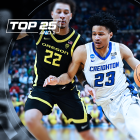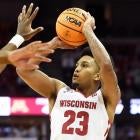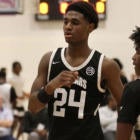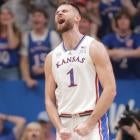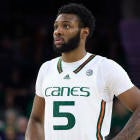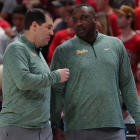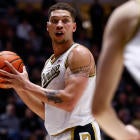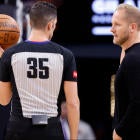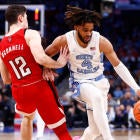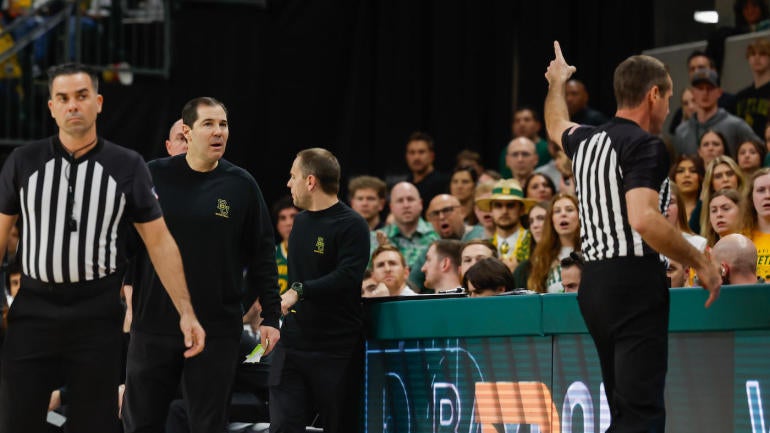
When Baylor coach Scott Drew was ejected in the second half of Saturday's intense 70-68 home win over Iowa State, it marked the first time in his 707 games as a head coach he got the hook. Drew received two technical fouls for lingering outside the coaching box (and for some excessive protesting, to be sure). The first-half T was earned: Drew was berating the refs while walking on the court during live action. A clear no-no.
The second technical seemed as flimsy as any you'll see all year.
"That second one better be a high threshold, and you don't throw someone out unless they're really chirping or cursing [the officials]," a Big 12 source unaffiliated with Baylor told CBS Sports.
Nevertheless, Drew was tossed after lobbying lead official Jeb Hartness — doing so while mostly out of the coaching box.
This is how Scott Drew gets kicked out of a basketball game #Big12? What’s the deal?! #Baylor pic.twitter.com/qpTRxZJnYd
— BillyBear 🚴♂️🐻⚽️🌮🏔️ (@wlpresley90) February 4, 2024
Ironically, one of the more congenial coaches in high-major hoops was a victim to something that I reported on last month. Coaches carelessly leaving the coaching box and walking onto the floor has been something of a pox on the sport for a long time.
"Hartness is notorious as an extreme letter-of-the-law guy," a Big 12 coach (not affiliated with Baylor or Iowa State) told CBS Sports.
The ejection incensed Baylor athletic director Mack Rhoades, who made a rare move by an AD and spoke at the postgame press conference, calling the officiating in Saturday's game "an embarrassment for this league. Period. ... This league needs to get better when we think about our officiating."
Rhoades has been fined $25,000 by the Big 12 and will be given a public reprimand from the conference office, a source told CBS Sports.
Hartness sending Drew to the locker room did not come as a surprise to some in the Big 12 for one reason: In mid-January, after CBS Sports' reporting on the pattern of bad behavior nationally with coaches constantly drifting onto the court, Big 12 coordinator of officials Curtis Shaw sent a stern memo to every head coach and every official in the league regarding bench decorum from all coaches and players. CBS Sports recently obtained the memo.
"Bench decorum has become a pressing issue and must be addressed," Shaw's memo reads. "Situations where head coaches are clearly on the court, head coaches are playing 'defense' on players near their sideline, assistant coaches that are standing during every play, and comments from players sitting on the bench directed toward their opponents must be addressed and penalized."
The memo stressed that "crews who do not handle these situations will be penalized."
Here's the memo obtained by CBS Sports—sent by Big 12's coordinator of officials—to all coaches + refs: "Bench decorum has become a pressing issue + must be addressed. Situations where head coaches are clearly on the court .. are playing 'defense' on players near their sideline." pic.twitter.com/8y3Ou1yOB0
— Matt Norlander (@MattNorlander) February 6, 2024
Shaw reminded coaches and officials that, even before an official warning is levied in the score book, an official can notify a coach two times that they need to stay off the floor. The third infraction triggers a warning and the fourth is a technical foul. There is also a section about "Coaches Defending Opponents."
The memo reads: "If a head coach is running the sideline toward an opponent or is getting behind a shooter or ball handler and screaming or waving their arms during a play it is an automatic 'T' foul for unsporting conduct. THIS IS NOT A WARNING it is a 'T' foul."
The memo also addressed assistants who are not allowed to consistently stand up throughout game play. Benches are at risk of technical fouls if their assistants repeatedly break protocol.
"Allow players and coaches to spontaneously react to plays or situations but penalize them when they are clearly abusing the bench policy," Shaw wrote.
Hartness' decision has come under a lot of criticism, but he also made the call amid increased scrutiny from the Big 12 office. Sources told CBS Sports that, until this season, the Big 12 had not been formally grading its officials. It was the last remaining power conference to neglect to do this.
"We did not rate our officials," a high-ranking source said. "Now we have an 'observer' that does. It was instituted this year for the first time in an effort to get better and be more accountable — and at arm's length of our coordinator (Shaw)."
It's wowing that it took the Big 12 until this season to have a formal process of grading its officials; many other leagues have had this practice in place for years. Even with Iowa State-Baylor being a choppily officiated game, Hartness as the lead ref knew his crew would be held accountable if they let Drew ignore the terms of Shaw's memo. It explains the controversial second technical.
"Warnings have been more frequent," another Big 12 coach told me. "I feel like they've been firm with us far more than what happened a month ago. The memo went out, everybody knows that for the next few weeks it'll be toe-the-line, ticky-tacky. So, for the next few weeks, calm down and it'll go back to normal."
Coaches in the Big 12 remain on heightened alert. I asked around other power conferences, and no memo similar to Shaw's was sent in those leagues, however NCAA national coordinator of officials Chris Rastatter told me he's communicated with every league's chief coordinator on this issue for months.
The Big 12 is the best league in college basketball. Nobody wants to see spotty officiating, or bad coaching behavior, get in the way of that.
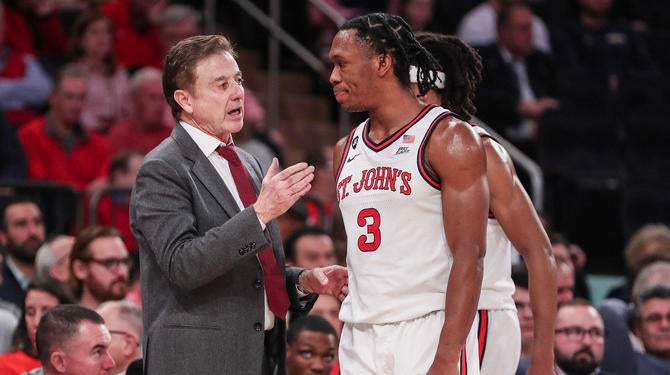
Pitino molding St. John's: 'It's going to take time'
More from the notebook after my trip to MSG on Saturday. UConn's win — and the scene the Garden provided — was the story then.
Now? Let's examine the result from the Johnnies' side. Going into the season, it felt 50/50ish that Rick Pitino would get a team overloaded with mid-major transfers into the NCAAs. At this point, the 13-9 Red Storm still project as a tournament team, but barely.
"They're better than us," Pitino said of Connecticut. "Doesn't mean you can't beat the No. 15 team."
Maybe. Saturday was a blown opportunity (there were 17 lead changes) for a gigantic upper-tier Quad 1 W. The defeat to (shorthanded) No. 1 UConn was SJU's fifth loss in six games.
"It's always been the turnover or the loose ball or the rebounding that has to get better," Pitino said of his team's missed chances at good wins in recent weeks, and he didn't stop there. "Without question, it's our defense. We're slow laterally, we're unathletic and we're small."
With February here, we've also officially entered allowable bubble-talk territory and it actually meaning something. The Red Storm own only two Quad 1 wins (2-7 overall) and have a Q3 loss against Michigan. Pitino acknowledged the Big East schedule was front-loaded — wins should be on the horizon — but that's a double-edged sword. Fewer tournament-quality wins now remain. St. John's may well head into the Big East Tournament needing to win at least one game.
"We can get a little bit of a run to get the confidence back," Pitino said. "[Daniss Jenkins is] playing like one of the top two, three point guards in the league. We've got to get the other guys to play at a high level and we're not getting them at a high level right now."
St. John's only has four guaranteed Quad 1 opportunities remaining. It also has two DePaul games (the first on Tuesday night), two Georgetown matchups and a home tilt vs. Seton Hall. Winning those won't move the needle, while losing any would torpedo its tourney résumé.
"It's who we are. We're not a great basketball team," Pitino said. "This is the Big East. I've been through it my first year at Providence. It's going to take time."
It's Analytics Month at the Court Report!
If you check in here weekly, you are certainly familiar with mainstream metrics that often shape discussions around college basketball: KenPom.com, BartTorvik.com, the NCAA's NET rating, ESPN's BPI.
Beyond that, though, college basketball is blessed to have an enthusiastic community of independent, data-driven analysts who elevate the conversation. So, for the month of February, the Court Report is spotlighting these folks and their metrics sites that make us smarter. In the process, we'll learn valuable stuff about teams and trends as we move closer to March. We're starting with a rising star in the college hoops data space, Evan Miyakawa.
Matt Norlander: For those who don't know, tell us what EvanMiya.com is and how it differs from KenPom, Torvik, etc.?
Evan Miyakawa: Thanks, Matt! EvanMiya.com is a college basketball advanced analytics website I started during the tail end of working on my Ph.D. in statistics in 2020. Some elements are similar to the other respected sites you mentioned, but part of what makes my site unique is it is very player-focused. I created an all-encompassing player value metric for college basketball, Bayesian Performance Rating (BPR), which gives a measurement of the impact of every single player. BPR trickles into other features, such as team ratings, team lineup efficiency tools, transfer portal projections, automated keys to victory for each team and lots more.
MN: For those who might not understand what "Bayesian" stats are/what they mean in context to your metrics, what's the simplest, most concise way to lay it out?
EM: The Bayesian approach gives us a mathematical way of combining "prior" knowledge about something with current information that is constantly being updated. As humans, this process is very natural to us. Suppose you were to go out to lunch with a new co-worker. Before your conversation, you would have a preconceived notion of that person based on your brief interactions around the office. Once you start talking face-to-face, you would start updating your perception of your co-worker based on your more personal discussions. Over time at lunch, your new interactions (current data) would start to outweigh your preconceived notion (prior data) of the other person. It's a silly example, but Bayesian statistics gives us a way of formulaically joining prior knowledge and current data in a mathematically sound way to give us the most accurate representation of what to expect in the future based on what we know now.
MN: Yep, that makes sense. What's the college hoops correlation on your site?
EM: Before a season starts, we already have some prior knowledge about how good each team will be before games have been played. As the season progresses, we gradually start allowing the new information we are learning about each team to update our beliefs. Applying a Bayesian model in this context makes it easy to combine prior knowledge about each team with new information as games are played, leading to the best predictions of what will happen the rest of the season.
MN: What else makes EvanMiya.com's algorithm unique in college hoops?
EM: One thing that makes my team and player ratings unique is I never fully discount preseason data when evaluating team or player strength. Instead, I always keep a small amount of prior knowledge in the model to lead to the best predictions of future performance, as determined by the Bayesian modeling strategy. When evaluating team résumés for bracket seeding, it is only fair to rank teams based on current season performance only. However, when it comes to predicting how teams will fare in March Madness, considering the preseason expectations for each team leads to a more predictive model. Many teams often revert slightly to their preseason projection once they reach postseason play. Teams highly ranked in the preseason but struggled mightily in the regular season often surpass expectations for their seed line, such as 8-seed Kentucky in 2014 and 11-seed Michigan in 2022. On the flip side, teams that overachieved in the regular season but weren't ranked in the preseason often struggle in the tournament (2023 Purdue is a recent example).
I wanted to highlight one of my favorite features of Evan's site: two-way efficiency rankings of different lineup combinations. I'm staunchly against single-person +/-, as it sorely lacks contextual value. But spread that out to three or four players? Then you've got some storytelling. That in mind, I was interested in which four-man combos have the highest success rate, regardless of who the fifth teammate is at a given moment.
Which teams should be most encouraged? Auburn, Houston, Iowa State, Purdue, TCU and UConn are the schools with multiple four-man mixtures in the top 25. And the most dominant? Purdue's quartet of Zach Edey, Mason Gillis, Fletcher Loyer and Braden Smith is the most efficient foursome with at least 400 possessions together at this stage of the season.
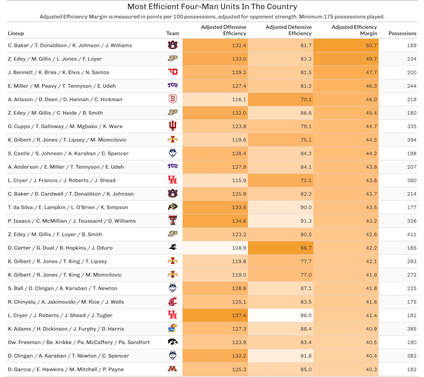
In the interest of eliminating potentially misleading noise in the data, Miyakawa set a minimum of 175 possessions played to this point in the season.
"The most interesting part of this is identifying certain units that are really working for a team and could provide more success for the team if they get more minutes together," he said, specifically citing Auburn, Indiana, TCU and Colorado.
And with Houston, its quartet of Shead, Cryer, Tugler and Roberts is more offensively efficient than ANY other foursome in the country (Houston is putting up 137.4 points per 100 possessions when those four are on the floor together). Kind of shocking, isn't it? At the same time, that group being relatively low defensively on Evan's metric has me hesitating a little bit; Shead and Roberts are irrefutably A-level defenders. Here's the thing: Cryer, Shead, Roberts and Ja'Vier Francis (just swapping one player) is a 72.1 Adjusted Defensive Efficiency (insanely good).
I also wanted to see top-10 data on the most efficient trios (without duplicating any teams.) Who truly has the best troika on both offense and defense? For this, Miyakawa set the bar even higher to filter out the fluff: a minimum of 450 shared possessions. Wouldn't you know it, the three top teams in the metrics have the three top troikas in the sport.
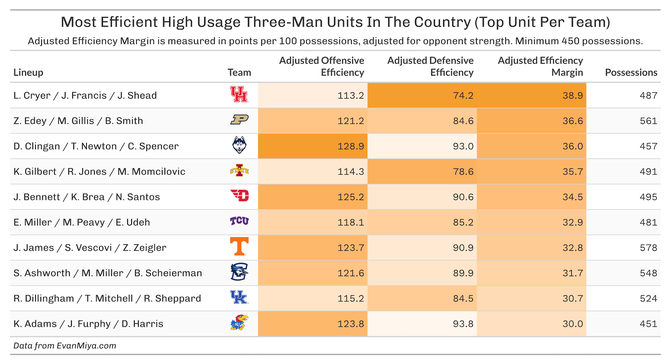
There are fascinating combos here. Tennessee doesn't include Dalton Knecht. Kansas doesn't include Kevin McCullar Jr. Creighton doesn't include Ryan Kalkbrenner. ISU doesn't include Tamin Lipsey. That's an encouraging development for Dayton, too, especially when you consider that DaRon Holmes II doesn't even factor into Dayton's most efficient trio? Wow.
While games are obviously played five-on-five, coaching staffs are becoming more and more attuned to which combinations within those lineups are providing consistency beyond eye tests and instincts. It's a blend. EvanMiya.com's data offers up a lot of new-age insight into how impactful players are — individually or in a group. If stats are your thing, add it to your list of college hoops resources.
@ me
The Court Report's weekly mailbag! Find me on X/Twitter or Bluesky and drop a Q anytime.
@MattNorlander Were your eyes on that madness at Creighton?
— Bob-O-Lite (@Bob_O_Lite17) February 3, 2024
Unfortunately, yes. Butler's 99-98 upset at Creighton took 22 minutes in real time to wrap up one minute of game action. Can't have that. Ever. Intolerable. That aside, the outcome punctured Creighton's long-term hopes of a top-three seed while also enhancing the Big East's chances of getting six teams into the NCAAs.
>>📬 Adam Vann via Bluesky asks: What can you tell me about the draft prospects of Danny Wolf, the 7-foot Ivy Leaguer with handle, range and vision? Seems like he could be worth a second-round flier.
Well-timed Q! I took my boys to see Princeton-Yale on Friday. (Good time, good game; Yale's got a charming home gym.) I spoke with Yale coach James Jones afterward about Danny Wolf (14.9 ppg, 9.8 rpg). He grew up a point guard and is capable of taking some wings off the dribble, in addition to having a keen passing eye. Fascinating player. He's not considered a ready-for-the-league prospect yet, but he's vying with Princeton guard Xaivian Lee as the best player in the Ivy League. The exact kind of player that could lift Yale to an NCAA Tournament upset if the Bulldogs get in over Cornell and Princeton.
If Edey gets injured next game for the rest of the season, is he still the POY? any other way he loses to knecht, davis, dickenson? thanks!
— Tokyo202021 (@tokyo202021) February 4, 2024
The lead Zach Edey has for national player of the year is comfortable, but it's not a lock-lock-lock. Perish the thought, but if Edey were to not play another minute this season due to injury, he'd for sure be a First Team All-American; RJ Davis and Dalton Knecht are the two players, as of now, who would be most likely to catch him for NPOY.
>>📬 NoPurposeFlour via Bluesky asks: What are Tennessee's biggest weaknesses and what kind of team should they be worried about?
The Vols have one Sweet 16 appearance under Rick Barnes, so it doesn't really matter if UT winds up winning the SEC or getting a No. 1, 2 or 3 seed; everyone's waiting to see if Barnes can get it together in the second half of March. If that doesn't happen, it will likely be on account of bad 3-point shooting (Tennessee makes 34%, ranking 168th) or its aggressive defensive nature leading to foul trouble ... which means Tennessee's largely inexperienced bench would be called upon in a high-pressure situation. Knecht has had a few bad days. He can't be a no-show in the NCAAs.
That was a trash no call on the outa bounds but ya. On a seperate note, what do you consider a rivalry? Gonzaga is 31-10 vs the Gales since 2010, those are not rivals in my book thats boot vs ant and sometimes the ant has a gun.
— Drew Davis (@Drew647A) February 4, 2024
Go look at the winning percentage Gonzaga has vs. every WCC program in the past 20 years and then compare that to Saint Mary's. The Gaels having double-digit wins vs. the Zags absolutely makes them a rival in this context, particularly when you consider they've managed to get out of the WCC with nine tournament bids in that span. There was "oh really?" reaction from some in the preseason when the Gaels narrowly edged GU as the pick to win the WCC. That now looks proper. Gonzaga has to win out until the WCC title game to have a viable at-large shot.
>>📬 Lyall Storandt via Bluesky asks: How many conference wins does Mike Boynton need to keep his job?
Oklahoma State is 10-12 (2-7 Big 12) in Boynton's seventh season. His buyout is about $8 million. If OSU goes 5-13 in the Big 12, I think he will get another year but be forced to make staff changes. Fewer than five wins, I could see movement — but boosters would need to be willing to foot the bill. (OSU is already in a pinch with money; it has one of the worst NIL setups in the Big 12.)
>>📬 Jake Schwall via Bluesky asks: Outside of Purdue, how are you confident in any other Big Ten teams making it out of the opening weekend of NCAA tourney?
I think there's a healthy shot Illinois and/or Wisconsin do it. Almost no confidence in anyone else at this stage. I'll say two Big Ten teams make the Sweet 16.
Norlander's news + nuggets
• Monday's regional ruling by the NLRB that Dartmouth's men's basketball players should be deemed employees (who would be paid by the school) has the potential to be universe-rocking (eventually) to NCAA schools. It's an important story, but it's not a big one yet. Read Dennis Dodd for more.
• Virginia's 60-38 win over Miami is a head-turner. The Cavs (18-5) have made the NCAAs every time they've had at least one five-game winning streak in the ACC. That can be a function of fortunate scheduling, but now UVa's gone off for eight straight. I think the Wahoos dance.
• The nation's longest win streak now belongs to first-year High Point coach Alan Huss. The Panthers have won 12 straight and sit at 9-0 atop the Big South. Congratulations to these five for reaching the midway point (at least) of conference play without dropping a league game just yet: Cornell (Ivy League); High Point; Saint Mary's (WCC); Vermont (America East); Yale (Ivy). The most recent team to run the table in league play? Oral Roberts last season en route to a 12-seed.
• UNC's gonna be a top-two seed, folks. For just the fourth time since the mid-1980s, North Carolina's opened up ACC play by winning at least 10 of its first 11 games. The three previous times (2001, 1998, 1987), UNC was a 1 or a 2.
• After opening the Court Report a week ago on Kentucky's worrisome defense, the Wildcats went out and made things worse! Back-to-back home losses with Florida and Tennessee combining for 197 points — the first time Kentucky let up 90-plus in two straight games in 30 years.
• Condolences to the Detroit Mercy family. It's tough enough that this program is enduring a merciless winless season (0-24) a year after Antoine Davis left as the No. 2 all-time scorer in men's history. Things were made worse with the unexpected passing on Sunday of Earl "The Twirl" Cureton, one of the most legendary players in school history.
• Shoutout to one of best grad transfers in college hoops — a mid-major one at that. Hofstra's Tyler Thomas is eighth nationally in scoring (21.7) and is coming off a week wherein he put up 24.5 points, 6.5 rebounds, 6.0 assists and 1.5 steals per game while playing 80 minutes in two close games that ended with Hofstra wins.













